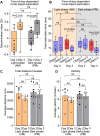A Protocol to Assess Time-of-Day-Dependent Learning and Memory in Mice Using the Novel Object Recognition Test
- PMID: 41000161
- PMCID: PMC12457838
- DOI: 10.21769/BioProtoc.5446
A Protocol to Assess Time-of-Day-Dependent Learning and Memory in Mice Using the Novel Object Recognition Test
Abstract
Changes in learning and memory are important behavioral readouts of brain function across multiple species. In mice, a multitude of behavioral tasks exist to study learning and memory, including those influenced by extrinsic and intrinsic forces such as stress (e.g., escape from danger, hunger, or thirst) or natural curiosity and exploratory drive. The novel object recognition (NOR) test is a widely used behavioral paradigm to study memory and learning under various conditions, including age, sex, motivational state, and neural circuit dynamics. Although mice are nocturnal, many behavioral tests are performed during their inactive period (light phase, subjective night) for the convenience of the diurnal experimenters. However, learning and memory are strongly associated with the animal's sleep-wake and circadian cycles, stressing the need to test these behaviors during the animals' active period (dark phase, subjective day). Here, we develop a protocol to perform the NOR task during both light (subjective night) and dark (subjective day) phases in adult mice (4 months old) and provide a flexible framework to test the learning and memory components of this task at distinct times of day and associated activity periods. We also highlight methodological details critical for obtaining the expected behavioral responses. Key features • Enables analysis of learning and memory in mice during both active (dark) and inactive (light) phases. • Allows for switching the time-of-day-dependent familiarization and recognition to study the impact of activity and sleep-wake cycle on cognitive performance. • Details the environmental and experimenter-dependent conditions that can impact behavioral responses. • Provides a flexible, adjustable platform for testing variable experimental conditions such as age, sex, learning and memory components, and genetic manipulations.
Keywords: Behavioral assay; Circadian rhythms/time of day; Learning and memory; Mice behavior protocol; Novel object recognition.
©Copyright : © 2025 The Authors; This is an open access article under the CC BY license.
Conflict of interest statement
Competing interestsThe authors declare no conflicts of interest.
Figures








References
-
- Ghafarimoghadam M., Mashayekh R., Gholami M., Fereydani P., Shelley-Tremblay J., Kandezi N., Sabouri E. and Motaghinejad M.(2022). A review of behavioral methods for the evaluation of cognitive performance in animal models: Current techniques and links to human cognition. Physiol Behav. 244: 113652 10.1016/j.physbeh .2021.113652 - DOI - PubMed
LinkOut - more resources
Full Text Sources

